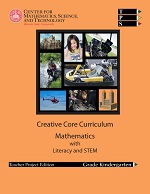Kindergarten Mathematics

Counting and Cardinality and Numbers of Operations in Base Ten
Helicopter Rescue
Students build small helicopters from colored construction paper, three drinking straws, and a couple of craft sticks. There are 10 of each color, each is given a number 0-9. Students use the helicopters to rescue victims of some natural event. Victims are made of construction paper with a paper clip attached. The helicopters have a hook for picking up the victims.
Knowing the number of victims, students can count rescued victims and subtract to determine the number still to be found. Helicopters are dispatched from bases, each containing 10 choppers in designated and numbered parking spots. Choppers 1 to 9 land, followed by "0." A "1" is placed in front of the "0" indicating a full base of ten. A chart with color coded numbers help students see place value for the first, second, and perhaps third group of ten. Another event has X number of victims. Since each helicopter can rescue 2 victims, students can determine how many choppers are needed.
Operations and Algebraic Thinking
Float Your Boat
Students test various bottle caps and small paper cups (cut down) to determine how many pennies each can hold. They classify the “boats” by capacity. All boats holding 10 or more pennies are removed. Students practice addition by selecting boats that will together transport certain quantities. They are given 10 pennies that must be transported from the beach to the waiting ship. Students select one boat from the display area and build another from foil to transport the remainder.
Measurement and Data
Classy Cars
Each student brings a toy car to class. The teacher has a few extras on hand. Cars are classified by color, type, etc. A list of what can be measured is determined and measurements are taken. A data table is made. Cars are classified by measurements. They are then rolled down a ramp and times are recorded. The cars are once again classified but this time by speed. The ramp is raised and the cars run again, and classifications are adjusted. Relationships between measurements and speed are identified.
Geometry
Castle Design
Students receive a drawing of a castle. They identify geometric shapes in the 2-dimensional picture by tracing them with colored markers. Different colors indicate different geometric shapes (triangles in red, squares in blue, circles in green, etc). They then go for a walk and identify geometric shapes around them in a journal by drawing sketches. They then design a castle using geometric shapes. Finally, they build the castle in 3-dimensions using paper towel tubes, cones (drinking cups), cubes (milk cartons), etc.